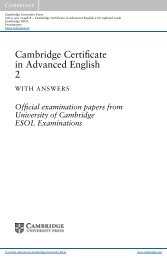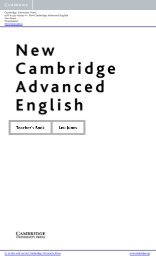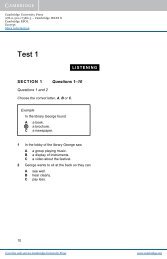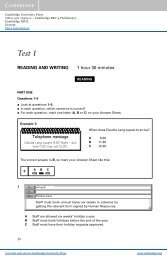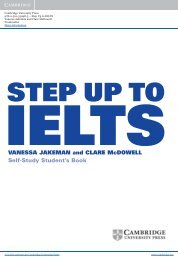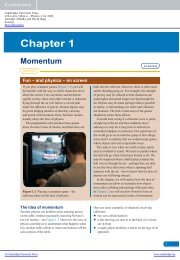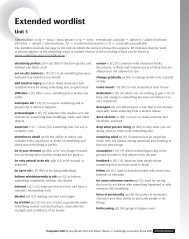Skills for Study Level 2 Teacher's Book - Cambridge University Press
Skills for Study Level 2 Teacher's Book - Cambridge University Press
Skills for Study Level 2 Teacher's Book - Cambridge University Press
You also want an ePaper? Increase the reach of your titles
YUMPU automatically turns print PDFs into web optimized ePapers that Google loves.
4d Students rewrite the results section <strong>for</strong> example A.5 Primary research reports – the discussion section5aSuggested answersADiscussion7When calculating the density of each sample of water the units were converted intoSI units.mass in kgDensity =volume in m = mass in g × 10 −33 volume in cm 3 × 10 −6The average density was then calculated as 995.3 ± 1.6 kg/m³ at 24°C.As Table 3 shows, the density result <strong>for</strong> the second measurement was noticeablylower than <strong>for</strong> the other measurements. It had been observed that air bubbles werepresent in the pipette when measuring out the 25.00 cm 3 water <strong>for</strong> this reading. 6 Thiswould have caused a systematic error in the volume, and hence reduced the densitycalculated, so this measurement was discounted.4Figure 2 shows the average density of water obtained in this experiment (includingerror bars indicating the range of values) in comparison with published data (Lide, 1990).The average density in the results was lower than the accepted value <strong>for</strong> waterdensity at that temperature.6This may be due to the researcher’s inexperience using the pipette, which allowedair bubbles to enter, or drops of water remaining in the beaker between recordings.These errors would both affect the mass of water measured, and hence the density.6Another consideration is the accuracy of the pipette used to measure the volumeof the water. The manufacturers state that the grade A pipette used is accurateto ± 0.03cm 3 . 7 Allowing <strong>for</strong> this increases the uncertainty in the average densitymeasurement quoted above to ± 2.9 kg/m³. If the error bars on the data point inFigure 2 were extended to include this greater spread, then the published dataat 24°C now lies within the range of the experimental results.Density of water (kg/m 3 )10051000995990985980975970965960955Published dataExperimental results0 50 100Temperature (°C)150Figure 2: CRC Handbook data <strong>for</strong> density of waterLide, D. R. (Ed.) (1990). CRC Handbook of Chemistry and Physics (70th Edn.). BocaRaton (FL): CRC <strong>Press</strong>Unit 2 Part E ∙ Reporting in writing 67



